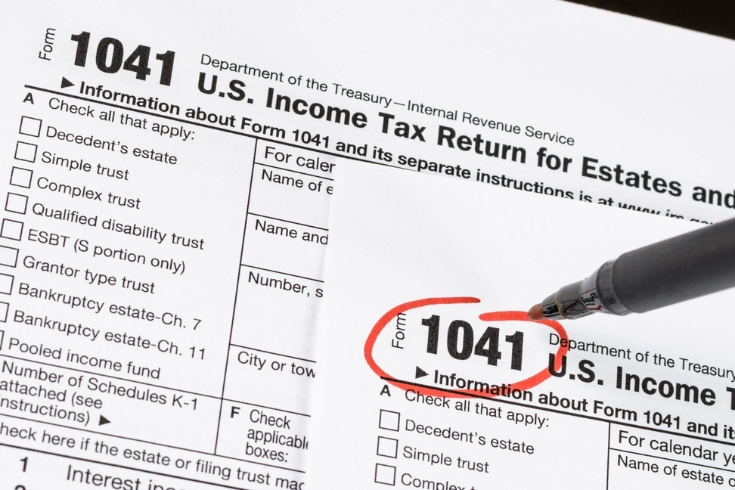Plan Smarter. Grow Stronger. Don’t miss our latest financial strategies.
November 11, 2025
Step-by-Step 1041 Tax Return Instructions
✅ Information Verified By a CPA

Filing taxes for an estate or trust differs from filing a personal return. When a fiduciary, such as an executor, trustee, or administrator takes charge, they’re responsible for reporting the estates or trust’s income using Form 1041, the IRS’s official fiduciary income tax return.
Many people encounter this form for the first time when settling a loved one’s estate or managing a trust, and the rules can seem unfamiliar or confusing.
Form 1041 is used to report income, deductions, and distributions related to estates and trusts. Unlike a standard Form 1040, it covers income earned after someone passes away, or income generated within a trust for its beneficiaries.
The distinction matters because the fiduciary must carefully track what belongs to the estate or trust and what passes through to individual beneficiaries. The challenge is that these filings sit at the intersection of estate administration and tax law.
Deadlines, such as the Form 1041 due date, rules for what is deductible, and the treatment of distributions can all impact both the fiduciary and the beneficiaries.
Here’s a step-by-step1041 tax return journey you can understand.
Understanding Form 1041 Basics
Form 1041 is the income tax return for estates and trusts. When someone passes away, their estate may still earn money from investments, property, or business activities.
A trust may also collect income on behalf of its beneficiaries. Instead of reporting that income on a personal return, the fiduciary files Form 1041 with the IRS.
Who Needs to File Form 1041?
An estate or trust must file Form 1041 if it earns $600 or more in gross income during the year. Filing is also required if any beneficiary is a nonresident alien, even if the income falls below that threshold.
The person responsible is the fiduciary, usually an executor, trustee, or administrator. The Form1041 due date is generally April 15 for calendar-year estates and trusts, though extensions are available if more time is needed.
Form 1041 vs. Estate Tax
Many people confuse Form 1041 with estate tax filings, but they serve different purposes. Form 1041 reports the income earned by an estate or trust. The estate tax return (Form 706), on the other hand, applies to the transfer of assets after death and is only required for estates that exceed the federal exemption limit.
Trusts also differ in how they are taxed. A revocable trust is treated as part of the individual’s return during life. An irrevocable trust stands alone and usually requires a fiduciary to file Form 1041 once it becomes active.

The Step-by-Step Filing Guide
Filing IRS Form 1041 may feel overwhelming but breaking it into steps makes the process easier. Below is a structured guide that fiduciaries can follow to complete the return accurately.
Step1: Gathering Your Documents for a Smooth Process
Before filling out Form 1041, gather all records related to the estate or trust. These typically include:
- Estate or Trust Document: This legal paper spells out who the beneficiaries are and how assets should be managed.
- Bank and Brokerage Statements: Needed to report interest, dividends, and gains.
- Property Records: Rental agreements, closing statements, or sale records for any real estate.
- Income Records: Forms, such as 1099 for dividends, interest, or brokerage activity.
- Expense Receipts: Attorney fees, accounting charges, court filing fees, and trustee fees are all examples.
- Prior Tax Returns: Helpful for carrying forward information or confirming past reporting.
Having complete documents ensures you do not miss income or deductions that should be reported.
Step2: A Line-by-Line Breakdown of Form 1041
The IRS organizes Form 1041 into sections. Each section tells a part of the estate or trust’s financial importance.
Part1: Income
The first step is to report all income earned during the year. Income for estates and trusts may come from different sources:
- Interest Income: From bank accounts, certificates of deposit, or bonds.
- Dividends: From stocks or mutual funds.
- Rental Income: Property owned by the estate or trust.
- Business or Farm Income: If the decedent owns a small business, this must also be reported.
- Capital Gains: From the sale of securities or property.
A common question is what is considered income for Form 1041.Income is not limited to cash received. For example, if a trust sells an investment at a gain, that gain is taxable even if the proceeds are reinvested instead of distributed.
If income is distributed to beneficiaries, it is reported on Schedule K-1. This shifts the tax burden from the estate or trust to the individuals receiving the income.
Part2: Deductions
The IRS allows certain expenses to be deducted from the gross income of the estate or trust. These deductions help reduce the taxable amount.
Typical Form 1041deductions include:
- Trustee Fees: Compensation for the person managing the estate or trust.
- Attorney Fees: Legal costs tied to estate settlement or trust administration.
- Accounting Fees: Costs of preparing returns or financial records.
- Administrative Expenses: Filing fees, postage, or other direct costs of handling the estate.
- Charitable Contributions: If the trust document allows donations, these may be deductible.
Itis important to note that not all expenses are deductible. For example, funeral expenses are not deductible on Form 1041. They may instead be deducted on Form706, which applies to estate tax.
Part3: Tax and Payments
After reporting income and subtracting deductions, the fiduciary must calculate the estate’s or trust’s tax liability. This step is crucial because it determines how much tax the entity owes or how much passes through to the beneficiaries.
Key points to remember:
- Compressed tax brackets: Estates and trusts reach the highest tax rates much faster than individuals. Even modest amounts of income can be taxed at the top bracket.
- Estimated payments and credits: Any estimated tax payments or credits carried over from prior years must be included.
- Distributions: Amounts distributed to beneficiaries reduce the estate’s or trust’s taxable income, but those distributions must then be reported by the beneficiaries on their personal returns.
For example:
If a trust earns $20,000 in dividends and distributes $15,000 to two beneficiaries, the trust reports the income but deducts the $15,000distribution. The beneficiaries then pay the tax on the income they receive.
The purpose of the 1041fiduciary income tax return is to show whether the estate or trust pays the tax, or it should be passed on to the beneficiaries.
Understanding Key Schedules
When filing Form 1041, some parts of the return require additional schedules. These schedules break down specific information for the IRS and for beneficiaries. The most important is Schedule K-1.
Schedule K-1: What to Know About Beneficiary Distributions
Schedule K-1 reports for each beneficiary’s share of the estate or trust’s income, deductions, and credits. Beneficiaries use this information to report income on their own tax returns.
The key points are:
- Each beneficiary receives a separate K-1 showing their portion of interest, dividends, capital gains, and other taxable income.
- Distributions made to beneficiaries reduce the estate or trust’s taxable income.
- The fiduciary is responsible for preparing K-1s accurately and sending them to beneficiaries on time.
- Common mistakes include reporting incorrect amounts or missing beneficiaries entirely, which can lead to IRS notices.
For example, if a trust earns $30,000 in total income and distributes$10,000 to one beneficiary and $20,000 to another, each K-1 will show their respective share. The beneficiaries then include these amounts in their personal returns.
Understanding Schedule K-1 is important because it ensures income is taxed in the right hands and helps avoid confusion or errors during filing.
Expert Tips and Best Practices
Filing Form 1041 isn’t simple and small mistakes can lead to big problems later. Keep these key practices in mind:
- Stay organized. Track all sources of income—interest, dividends, rentals, and any business activity—and record every expense, including trustee fees, attorney fees, and administrative costs.
- Double-check every number. Missing income or overstating deductions can trigger IRS inquiries. Meeting the Form 1041 due date is also essential to avoid late-filing penalties.
- Seek professional help when needed. If the estate has multiple beneficiaries, complex investments, or unusual assets, hiring a CPA is the smartest move. A tax professional can prepare Schedule K-1accurately, apply all eligible deductions, and guide you on differences between revocable and irrevocable trusts. This ensures taxes are reported correctly and reduces stress for everyone involved.
CPA firms like Sproutax save valuable time and help protect beneficiaries from unexpected tax consequences.
Conclusion
Filing Form 1041 can feel complicated, but it is an important responsibility. Handling income, deductions, and beneficiary reporting carefully ensures the estate or trust runs smoothly. Mistakes can lead to stress, delays, or unexpected taxes.
Staying organized and informed protects the estate and its beneficiaries. For complex situations with multiple beneficiaries or investments, professional guidance is invaluable. A CPA can help file accurately, save time, and provide peace of mind.
Take action now to prevent problems later. If you want expert support, Sproutax can guide you through filing your Form 1041 accurately and efficiently.
FAQs
Do I need to file Form 1041 if the estate or trust has no income?
An estate or trust must file Form 1041 if gross income exceeds $600. If income is below this threshold and there are no non-resident alien beneficiaries, filing may not be required. Always check who files Form 1041 to be sure.
Can I deduct funeral expenses on Form 1041?
Funeral expenses are generally not deductible on Form 1041. Only administrative and management costs of the estate or trust, such as trustee fees, attorney fees, and court costs, can be claimed as Form 1041 deductions.
What happens if I don’t file Form 1041 on time?
Late filing can result in penalties and interest. The IRS may assess fees based on unpaid taxes. Meeting the Form 1041 due date is essential to avoid extra charges and maintain compliance for the fiduciary income tax return.
What is the difference between a revocable and irrevocable trust?
A revocable trust can be changed or revoked at any time during the grantor’s lifetime. In contrast, an irrevocable trust generally cannot be modified or terminated once it’s established.
Only irrevocable trusts typically require the fiduciary to file a separate Form 1041 once the trust begins generating income.









.svg)
.svg)